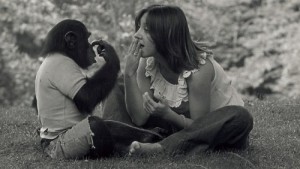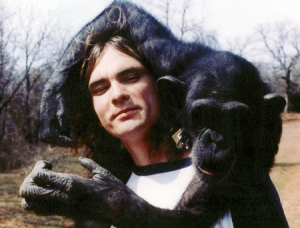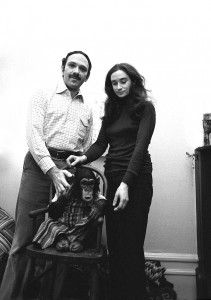

By Mike Wilmington Wilmington@moviecitynews.com
Wilmington on DVDs. Pick of the Week: New. Project Nim
“Project Nim” (Four Stars)
U.S.-U.K.: James Marsh, 2011 (Lions Gate)
I. Let’s Play.
— Nim
 He was a gnarled, hairy old chimpanzee, who spent most of his time in a large cage with two chimp companions and an occasional human visitor or keeper. He moved slowly and a bit painfully and he had a strange, sad, almost frowning expression — as if he expected so little out of the day, so little from his human captors, so little out of life, that it fatigued him even to think about it — but that, despite it all, he would continue to explore his severely limited little world anyway, a world of which he knew almost every inch.
He was a gnarled, hairy old chimpanzee, who spent most of his time in a large cage with two chimp companions and an occasional human visitor or keeper. He moved slowly and a bit painfully and he had a strange, sad, almost frowning expression — as if he expected so little out of the day, so little from his human captors, so little out of life, that it fatigued him even to think about it — but that, despite it all, he would continue to explore his severely limited little world anyway, a world of which he knew almost every inch.
Ah, no. that’s some love-me-love-my-chimp trash for a modernized comic book version of “The Jungle Book” or “King Kong, Jr.“ or some pseudo-Kipling stuff. I’ll get good and crucified for that. No, I just can’t try to feel or see or talk like Nim, because I can’t really talk to him.
I can’t… But once upon a time, you know, I really could have talked to Nim. We all could have talked to him, with him, if we knew or could learn the sign language of the deaf and mute. That time is gone, we lost it, we threw it away, and that’s Nim’s Story as told in the wonderful movie Project Nim: the story of what he achieved, what he gained, and what he lost. And of what we all may have lost because of it.
Its not the story you think, unless you’ve heard or read of it before, maybe in the book “Nim Chimpsky: The Chimp Who Would be Human,“ by Elizabeth Hess. It’s a story of man and beast, of the beast in some humans, and of the human in one beast. It’s the story of Nim, whom we all should remember — and whom we all should love.
Let’s play.

2. “Speech is a faculty given to men to conceal their thoughts.”
— Charles-Maurice de Talleyrand.
Few films in recent years have moved and disturbed or impressed me as much as Project Nim, James Marsh’s documentary about the chimpanzee named Nim Chimpsky, of his life and hard times, of his rise and fall, of how he was taught to be almost human and then punished for being a chimpanzee.
It’s a great movie, moving and sometimes funny and absorbing and profound and absolutely unforgettable, a classic-to-be, I’m sure — though it’s perhaps not the kind of film that’s going to attract large audiences looking for conventional feel-good entertainment and automatic uplift. There’s no standard uplift here, except for that quickening of our deepest sympathies that accompanies all great, sad, true works of art. And, after the amazing beginning, after our realization that a Columbia Univeristy educator is actually going to try to talk with a chimpanzee, and after seeing student Nim’s first triumphs, there’s little to feel really good about, especially if you‘re human. Project Nim is a kind of tragedy, pulsing with sorrow and warm with compassion, and it reflects very badly, not on Nim, but on some of the people around him.
James Marsh, who directed Project Nim, also made part of the brilliant, horrific British Yorkshire-set neo-noir trilogy Red Riding (the central section) as well as another great, riveting documentary: the Oscar-winning Man on Wire. Man on Wire is the tale of a French high-wire walker, Philippe Petit, who, without official permission, walked a wire between the Twin Towers of the newly-built World Trade Center, at the top, with no net, and is still alive to tell us all what happened. It’s an incredible work, one that arouses your worst fears (mine anyway), but also shows how genius and near-insane recklessness and great pioneering spirit can sometimes get all mixed together and produce something extarordinary.
Marsh’s Project Nim is the story of another daring leap into the unknown, but one in which almost everybody involved somehow stumbled and fell — Nim as well. In it, Marsh does something that critics of documentaries often violently oppose: He mixes interviews and archive footage of the Nim story, with dramatic creations of other scenes, witnessed, but not filmed at the time. There’s an animatronic Nim somewhere in the film and actors play some of the interviewees or principals in younger, unfilmed years — but all of this is so beautifully and seamlessly done that, while watching the movie, I never thought about what was real and what was staged, as I often did, for example, in Kevin Macdonald‘s excellent, partly restaged 2003 mountain-climbing documentary Touching the Void .
What Marsh has made, with the aid of producer Simon Chinn, cinematographer Michael Simmonds, composer Dickon Hinchcliffe (of British rock group Tindersticks), editor Jinx Godfrey, the nine main interviewees, and Project Nim’s animatronics, animation and primate choreography experts, is a great story superbly well told. Project Nim shows us the real Nim as cameras preserved him, but also recreates the unfilmed Nim we couldn’t see. It’s one of the finest, most deeply moving and instructive stories any film has recently given us, or could give us: an amazing investigation into what it means to be human. And to be animal…
The first humans Nim the chimpanzee violently encountered were the team of researchers, in November, 1973, who opened the cage at the Oklahoma primate center where Nim’s mother was cradling him in her ams, and shot a tranquilizer dart into her, and pulled him screaming with fear from her embrace. (Nim and his mother would never meet again). He was then carried off to New York City, where he would become part of an incredibly ambitious experiment led by Profesor Herbert Terrace (one of the film‘s main interviewees), a behavioral psychologist from Columbia University.
Terrace believed that, if he could bring up a young chimpanzee away from other chimps and especially away from his mother (chimp mothers being unusually affectionate and protective), if he gave Nim a human “mother” and treated him as a human child, the chimpanzee could be taught sign language, and eventually taught to form complete sentences, use language as we do, and communicate and “talk” with humans. That would be not just some radical Dr. Dolittle fantasy, but an immense historic breakthrough.
So Professor Terrace found a willing volunteer to take Nim into her home and treat him as if he were her child: Stephanie Lafargue, an ex-psychology student of the professor‘s (and not unimportantly, a former lover) who lived with her children (including another interviewee, daughter Jenny Lee) and Stephanie’s writer husband on the Upper ‘70s West Side of Mahattan, one of the poshest, smartest areas anywhere. Stephanie threw herself enthusiastically into the project with Nim — whose name “Nim Chimpsky,” was a joking riff on the name of the linguist/political activist Noam Chomsky, a famous thinker who believed animals couldn’t talk to us.
Nim‘s first foster home, at the LaFargue‘s proved less than ideal. Most of the family liked him and accepted him, but Nim himself grew possessive about Stephanie and even began to try, with chimp-like cunning, to sabotage her marriage. (Maybe Stephanie‘s early breastfeeding of Nim was a real mistake. At any rate it helps move this section of the film into a comedy of radical chic bourgeois manners.) And though the Lafargues’ indulgent household enjoyed Nim (and he enjoyed them), they seemed little interested in the rigors of scientific experimentation, of teaching, and of recording results.
Worse, Nim had begun to bite people, though he often said “I‘m sorry“ after he hurt someone. (Some skeptical reviewers of this film are obviously suspicious of Nim‘s frequent apologies for bad behavior, feeling that he‘s insincere. I suspect and think, very simply, that Nim was sorry and that he really meant it. But, if Nim were capable of deviousness and manipulative insincerity, wouldn’t that be stronger proof of his closeness to humanity?)

Dr. Terrace decided to try something different. He cut a deal with the Columbia University owners of a large suburban mansion in Riverdale, The Delafield Estate, to house Nim and his teachers and housekeepers there rent-free, where his education could proceed in a more orderly fashion. Nim‘s first teacher there — Laura-Ann Petitto, another of Prof. Terrace’s psychology students (and, unhappily, another of his lovers later on), proved a Godsend: tirelessly teaching Nim sign language until eventually, thanks to Laura and her successors, he built up a vocabulary of 125 words, all of which he used fluently and easily — and even combined into what most of us would call sentences. One of the words he learned, and used often when Professor Terrace visited the Delafield Estate, was the name “Herb.”
But the indefatigable Laura — who became a world famous and much awarded cognitive neuroscientist and an expert in language and its structures — also got uncomfortable with the Herb situation, and left, to be replaced by students Joyce Butler and Bill Tynan. They both got along well with Nim (a very personable chimp, it seems) and they also helped give their charge (and obviously also, their friend) a taste for a beer and an occasional joint. The project seemed an enormous success so far. (125 words? I know some movie critics who don’t seem to have vocabularies of more than 125 words, four of which are “problematic,“ “preposterous,” and “pitch perfect.”)
One suspects the young Nim was in a kind of paradise at Delafield: living in a beautiful home with wide, beautiful gardens and fields, with plenty of food to eat and friends who liked him and taught him things and talked to him and played with him all day long. Nim especially loved playing with the Estate’s cats, whom he held and hugged as tenderly as his lost mother had once embraced him.
 For all Nim knew, Delafield was what the world was like for all of his kind, though, since his keepers had been careful never to show him another chimpanzee (not a wise strategy perhaps), he may have had little idea what his “kind” was, beyond that odd hairy face that occasionally peered out at him from a mirror.
For all Nim knew, Delafield was what the world was like for all of his kind, though, since his keepers had been careful never to show him another chimpanzee (not a wise strategy perhaps), he may have had little idea what his “kind” was, beyond that odd hairy face that occasionally peered out at him from a mirror.
Yet Nim was definitely a learner. He was also a creator. He even created or invented a word of his own. When Nim grinned and clapped his hands together (or when his human friends did), it meant “Let’s play!” Surely this was unique. Surely Nim is the only chimpanzee who ever coined a word or a phrase in any language other than Chimpanzee — using it repeatedly in his frequent talks with Laura, Joyce, Bill and others, and, every once in a while, with Herb.
SPOILER ALERT
Also helping out Joyce and Bill was a professional interpreter for the deaf and sign language expert named Renee Falitz. It was an incident with Renee, though, that suddenly brought the experiment to a screeching halt, closed the gates of Nim‘s paradise, and sent him packing back to the primate center in Oklahoma. One morning Renee was preparing Nim for the day when he suddenly leaped at her, grabbed her tightly and bit her face so savagely he cut through to the bone. He was pulled loose, and, almost immediately, he signed to Renee the hand signals that meant “I’m sorry.”
END OF SPOILER
Why did Nim do it? No one speculates much here; it’s hard to speculate on any rash incident that ruins a life. Renee obviously still thinks ill of him. (Who could blame her?) Dr. Terrace closed down the experiment, dissolved the staff and send Nim off to Oklahoma to learn to live with his own kind. Bill and Joyce found it devastatingly hard to say goodbye.
In retrospect, all this seems to me like a big, big mistake — just as it seems a mistake not to have had a professional animal trainer on hand at Nim’s homes to handle Nim in his more difficult moments — instead of relying simply on Nim‘s three psychology student “mothers” (Stephanie, Laura and Joyce), on a college student using the project to complete his course work (Bill), and on a sign language expert (Renee) to takes care 24/7 of an animal known for sometimes volatile and violent behavior. The ’70s are famous for naivete as well as idealism, and Project Nim seems to have been blessed and cursed with both.
III.
 “Driving that train
“Driving that train
“High on cocaine,
“Casey Jones, you better watch your speed.
“Trouble ahead,
“Trouble behind,
“And you know that notion once caught my mind.”
— Jerry Garcia, Robert Hunter and The Grateful Dead
Back in Oklahoma, where the baby Nim had been torn screaming from his mother’s arms, he now had to learn to live penned up in a cage with many others, screeching and jabbering, and to socialize with these chimpanzees, a strange (to him) species whom he had never really seen, except briefly in mirrors. Professor Terrace came back just once to see him, with Nim recognizing him and excitedly signing “Herb” over and over again in happiness, believing no doubt that Herb was there to rescue him. But Professor Terrace took some photos, stayed a while, and then went off and never returned.
Yet even though Nim now seemed deserted by everyone he had known, by all his helpers and tutors and keepers, the Chimp Who Would be Human now gained another human companion, a lifelong supporter and, as it happens, his very best friend: Bob Ingersoll. Bob was a psychology graduate (not, however from one of Prof. Terrace’s classes) and he was also a huge fan of The Grateful Dead and therefore sympathetic to the taste for weed Nim had acquired at Delafield. The two of them would sit together out in the sun outside the cages and share a beer and talk together with sign language, and pass a joint and just…play. Perhaps Bob occasionally brought out a recorder or boom box, and played, for his Nim, the Grateful Dead singing “Truckin‘ or “Dark Star” or “One More Saturday Night” or “Casey Jones.”
At any rate, they liked and appreciated each other, and they had fun and mellow times, and Bob, like Laura, brought something special and important to Nim. In Bob’s case: True friendship. Bob says (and I’m sure he means it, and I’m sure its true) that he would rather have spent time with Nim than with anyone, including the Dead‘s legendary lead guitarist/composer Jerry Garcia. Coming from a confirmed Deadhead, that’s an amazing testimonial to Nim’s good fellowship.
There have been some critics of Project Nim who suggest that Bob and others, by introducing Nim to marijuana and teaching him to smoke, became another part of the tragedy of Nim‘s abuse by humankind. Surely they jest. There seems little evidence of bad reactions, bad dope, or of Nim acquiring bad companions, falling into criminal behavior, or graduating to the harder stuff and risking arrest, or all the other hazards of pot. If there was, then surely the state of Oklahoma has lost its sense of humor.
Because of Bob, who treated Nim as his best pal, the primate center maybe become another paradise for a while: a truer, less deceptive paradise than Delafield (which Nim, who had a long, long memory, almost certainly recalled well.) But it turned out to be just as transitory a good time, just as vulnerable to politics and budgets. Eventually, funds dried up, the center was closed, and Nim was sent off to a much-feared place: N.Y.U.‘s Lemsit Medical Laboratory, where chimpanzees are subject to medical experiments, including AIDS tests — until Bob made a stink. And so did crusading reporters and a persistent attorney.
 To quell the fuss, Nim finally wound up at Black Beauty Ranch for abused animals, the pet project of Cleveland Amory, the famous writer, animal activist and author of “Who Killed Society?” That should have been the happy ending for Nim, but wasn’t quite, since the Black Beauty Ranch — named for Anna Sewell’s children’s classic about a much-abused beautiful black horse who finally finds happiness — was, it seems, ill-equipped to deal with chimpanzees. They locked Nim in a cage by himself and wouldn’t let his best pal Bob come and visit him.
To quell the fuss, Nim finally wound up at Black Beauty Ranch for abused animals, the pet project of Cleveland Amory, the famous writer, animal activist and author of “Who Killed Society?” That should have been the happy ending for Nim, but wasn’t quite, since the Black Beauty Ranch — named for Anna Sewell’s children’s classic about a much-abused beautiful black horse who finally finds happiness — was, it seems, ill-equipped to deal with chimpanzees. They locked Nim in a cage by himself and wouldn’t let his best pal Bob come and visit him.
So now Nim was safe from experiments, but all alone. The big chimp who had hung out constantly with humans in his early years and tenderly cradled little cats in his huge hands, was branded a danger (to society?) and kept apart from us. Bob was banned from the premises. No friends. No music. No play.
It took a new management, ten years later, to loosen up the rules, and get Nim two chimp companions in his cage, and let Bob come and visit him, which he did, and so did Stephanie, who got a rude hostile greeting from the chimp she had once mothered. (But she apparently understood and forgave.)
Now, at last, we find Nim a bit past the place and the cage we imagined at the beginning of this review, in italics. He never became the world’s most famous chimpanzee. Maybe he never learned any more words. Eventually in 2000, after living most of his life in cages, at the age of about 27, Nim died. I don’t remember a fuss being made about it in the media; in fact, I don’t remember anything about him in the media at all. I’ll bet most of you probably never heard of Nim Chimpsky until James Marsh’s movie, and now the DVD, came out.
We should have. Of all the cruel things done to Nim, after he was kidnapped into the Groves of Academe and The Milk of Paradise — and there are many and some seem unforgivable (though chimpanzees, Dr. Mahoney of Lemsit says, are themselves very forgiving) — perhaps the worst is what Prof. Terrace said on TV about his prize pupil, decades ago, after the experiment fell apart. The good doctor proclaimed Project Nim a failure and said that Nim‘s 125 words and his many combinations (Give Nim a banana) were merely begging, and not true sentences or true communication. Really? Terrace had taken away Nim’s life. Now he took away his achievement and his fame and, it seemed, his place in history.
Now, I understand that Columbia University had to cover its ass somehow, in the event of lawsuits and condemnation from wisecracking college-budget-conscious conservatives. But isn’t “Give Nim a Banana!“ or “I’m Going“ and the rest communication? Or at least a good start? What the Hell kind of sentence was Terrace looking for? “To be or not to be: that is the question?” “So we beat on, boats against the current, borne back ceaselessly into the past?” “Nothing beside remains: Round that colossal wreck, the lone and level sands stretch far away?“ “Gregor Samsa awoke one morning to discover that he had been turned into a huge cockroach? (Or a huge chimpanzee?)” “I think, therefore l am?” “E = MC2?”
What Nim said to his human friends (and sometimes it’s on screen, in subtitles) all seem like sentences and intelligent communication to me, just as do many similar pithy utterances you often hear among us humans. (“It’s raining.“ “It’s snowing.“ “What’s happening?“) Just as is that most familiar bit of Thanksgiving chatter, “Pass the turkey.” (Or is that begging?)
I wonder if — when Professor Terrace left Nim forever at the Oklahoma primate center, ignoring at the end all his protege’s joyous, maybe frantic, signings of “Herb! Herb!”– he had the decency and gratitude to say to him the simple words ”Goodbye,” and “Thank you, Nim.”
Oh Nim. Humans sorry. Forgive us.
Most movie critics like this movie, as well they should. (It’s a beauty.) But a few writers seem to be trying to use the film’s undeniable drama and pathos to downplay Nim himself. Why didn’t we foolish humans just leave him alone and let him be a happy chimp?
Yet, on sober reflection, after watching Marsh’s profound and deeply compassionate movie, I really think that what Nim (and his teachers) did was incredible and deserves loud and fulsome celebration. Project Nim is, on one level, a heroic tale of the beauties and dangers of communication. And the heroes are Nim and Laura and Bob. (What’s Herb? Hero, in a way? Anti-hero?) Despite the incident that cast Nim out of his Eden, I wish myself the experiment had gone on, but with adequate supervision. I wish Nim had learned new words all his life and died, happy and celebrated. I even wish Bob Ingersoll had somehow been able to take his pal to a Dead concert. (I guarantee that’s a scene that will be discussed for any for any movie fictional dramatization of the story, and I hope they have sense enough not to use it for anything but a dream sequence.)
It sounds like this experiment will never be tried again, and it shouldn’t be, at least under Terrace‘s strictures. But in a way, I wish it could be done again differently — perhaps this time beginning not with the traumatic act of ripping a baby chimpanzee from his mother’s arrms and banishing him or her from chimpanzee society, but using several chimps and maybe their mothers all learning together with the researchers. Didn’t anyone on Project Nim ever feel, for even a moment, that the abrupt and violent disappearance of Nim‘s real mother from his life might have helped make him violent?
Too naïve? Too idealistic.Too 1970s? Maybe. I’m sorry. But if some professor and students ever do try to teach some chimpanzee as smart as Nim how to talk again, and if he (or she) gains as large a vocabulary, I hope they add one special word or phrase (or SENTENCE dammit!) to that vocabulary, in honor of the most remarkable chimpanzee who ever lived.
That would be the word, or sentence, that Nim himself created and invented. You remember it, of course. You look at your friend and smile. You clap your hands together delightedly. It means “Let’s play!”














